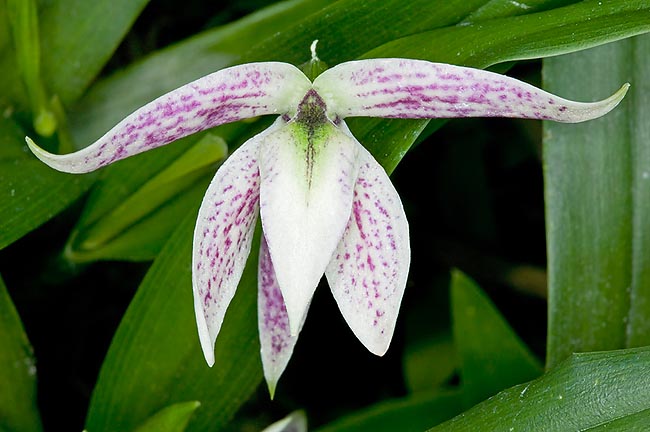Family : Orchidaceae

Text © Pietro Puccio

English translation by Mario Beltramini

The Prosthechea garciana is a vigorous and easy to cultivate Venezuelan epiphyte © Giuseppe Mazza
The name of the genus comes from the Greek “prostheke” = appendix, with reference to the appendix present on the column of the species type; the species is honoured to the Venezuelan collector and orchids expert Carlos Garcia Esquivel.
The Prosthechea garciana (Garay & Dunst.) W.E.Higgins (1998) is an epiphytic species with creeping rhizome from which originate some fusiform pseudobulbs, slightly compressed, 3-6 cm long and 0,8-1,5 cm thick; usually surmounted by only one elliptic leaf, 4-12 cm long and about 2 cm broad.
It has a terminal inflorescence, 4-7 cm long, wrapped initially by a flat bract (spathe) which has the duty to protect it during the initial phase of its development, carrying 1-2 flowers, of about 4 cm of diameter, of a colour varying from cream white to greenish white, spotted of purple, perfumed and long lasting, 6-10 weeks. Sepals and petals are lanceolate, fleshy, 2,5-3,5 cm long; the labellum, bent upwards, is almost ovate with pointed apex, about 2 cm long and 1 cm broad. It reproduces by seed, in vitro, and by division at the time of the vegetative regrowth.
It is a small species, vigorous and easy to cultivate, with an autumnal flowering particularly charming and unusual for the disposition of the flowers, upside down, vis-à-vis that of the great majority of the orchids, as is the case of the Prosthechea cochleata.
It requires high luminosity, but not direst sun, medium-high temperatures in summer with high atmospheric humidity, 60-80%, and regular waterings. In winter, after the flowering, it does not need a precise period of resting, but cooler temperatures, with nighttime lows around the 12-14 °C, and a slight reduction of the waterings allowing the compost to partially dry up.
Good ventilation is essential in all seasons. For the waterings and the nebulisations, are to be utilized rain water, or water obtained by reverse osmosis, or demineralised; the fertilizations, duly distributed and alternated, in way to avoid salts accumulations at the roots, are to be done during the vegetative period preferably with hydro-soluble balanced products, with microelements, at ¼ of the dosage suggested on the package.
It can be mounted on bark, raft of cork or of arborescent ferns roots, or cultivated in pots or baskets with a much draining and aerated compost, which can be formed by medium sliced bark fragments, sphagnum and charcoal.
The species is inscribed into the appendix II of the CITES (species whose trade is internationally ruled).
Synonyms: Epidendrum garcianum Garay & Dunst. (1961); Encyclia garciana (Garay & Dunst.) Carnevali & I.Ramírez (1986); Anacheilium garcianum (Garay & Dunst.) Withner & P.A.Harding (2004).
→ For general notions about ORCHIDACEAE please click here.
